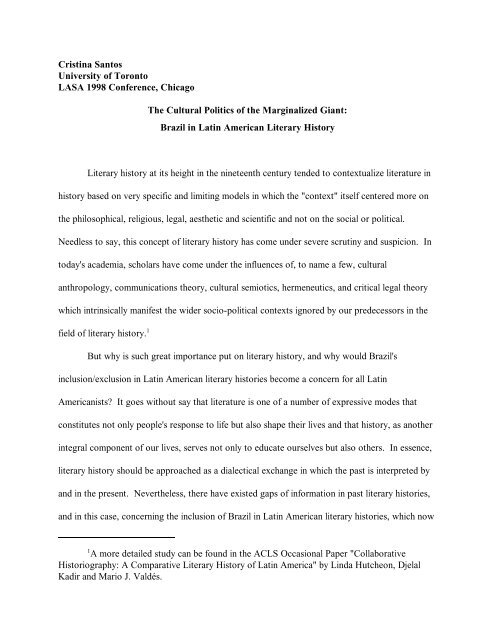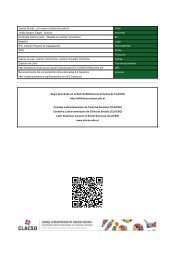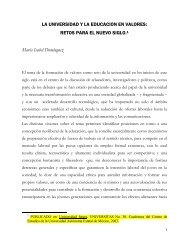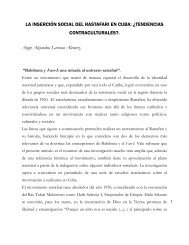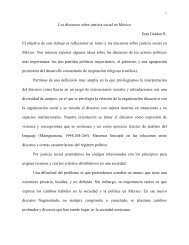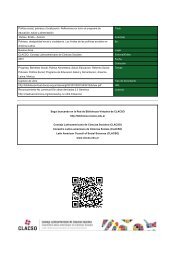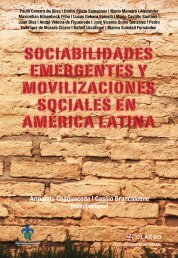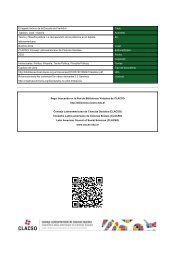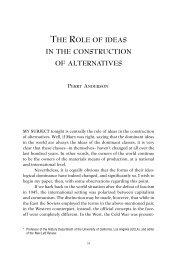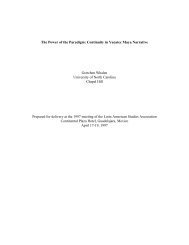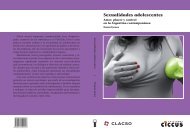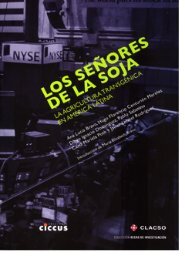A more detailed study can be found in the ACLS Occasional Paper ...
A more detailed study can be found in the ACLS Occasional Paper ...
A more detailed study can be found in the ACLS Occasional Paper ...
- No tags were found...
You also want an ePaper? Increase the reach of your titles
YUMPU automatically turns print PDFs into web optimized ePapers that Google loves.
3i<strong>be</strong>roameri<strong>can</strong>a , twelve o<strong>the</strong>r literary histories are also published about Hispanic America,exclud<strong>in</strong>g Brazil. Ironically, one also f<strong>in</strong>ds that <strong>the</strong> Brazilian, Manuel Bandeira, published hisSANTOS 3Literatura Hispano-Ameri<strong>can</strong>a for <strong>the</strong> first time <strong>in</strong> 1949 and had its second pr<strong>in</strong>t<strong>in</strong>g <strong>in</strong> 1960. 4Dur<strong>in</strong>g <strong>the</strong>se same years one f<strong>in</strong>ds that fourteen literary histories were published dedicated solely5to Brazil. Interest<strong>in</strong>gly, <strong>in</strong> 1959 Joaquim de Montezuma de Carvalho publishes <strong>in</strong> Angola his four3 Anderson Im<strong>be</strong>rt, Enrique. Historia de la literatura hispanoameri<strong>can</strong>a. México: Fondo deCultura Económica, 1954.Aubrun, Charles V<strong>in</strong>cent. Histoire des lettres hispano-américa<strong>in</strong>es. Paris: Armand Col<strong>in</strong> (Sectionde langues et littératures, 291),1954.Ayala Durante, Crispín. Resumen histórico crítico de la literatura hispanoameri<strong>can</strong>a. Madrid:SAEFA, 1945.Baz<strong>in</strong>, Ro<strong>be</strong>rt. Histoire de la littérrature américa<strong>in</strong>e de langue espagnole. Paris: LibrairieHachette, 1953._____. Historia de la literatura ameri<strong>can</strong>a en lengua española. Buenos Aires: Editorial Nova,1954.Bell<strong>in</strong>i, Giuseppe. La letteratura Ispano-Ameri<strong>can</strong>a. Milano: La Goliardica, 1959.Hamilton Depassier, Carlos. Historia de la literatura hispanoameri<strong>can</strong>a. Vol. I: Colonia y sigloXIX. New York: Las Américas Publish<strong>in</strong>g Co., 1960.Henríquez Ureña, Pedro. Historia de la cultura en la América Hispánica. México: Fondo deCultura Económica, 1947._____. Literary Currents <strong>in</strong> Hispanic America. Cambridge, Mass.: Harvard University Press,1945.Leguizamón, Julio A. Historia de la literatura hispanoameri<strong>can</strong>a. Vol. I-II. Buenos Aires:Editorial Reunidas, 1945.Perés y Perés, Ramón Dom<strong>in</strong>go. Historia de la literatura española e hispano-ameri<strong>can</strong>a.Barcelona: R. Sopena, 1947.Sánchez, Luis Al<strong>be</strong>rto. Nueva historia de la literatura ameri<strong>can</strong>a. Asunción: Guarania, 1950.4Rio de Janeiro: Editora Fundo de Cultura, 1960.5Amora, Antônio Soares. História da literatura Brasileira (Séculos XVI-XX). São Paulo:Saraiva, 1955.Bandeira, Manuel Carneiro de Sousa. Brief History of Brazilian Literature. Trans. and ed. RalphEdward Dimmick. Wash<strong>in</strong>gton, D.C.: Pan Ameri<strong>can</strong> Union (Pensamiento de América),1958.Barreira, Dolor Uchoa. História da literatura Cearense. Tomo I. Fortaleza: Instituto do Ceará,1948.Calmon, Pedro. Historia da literatura Bahiana. 2a ed. Rio de Janeiro: Olympio (Col.
SANTOS 5One must keep <strong>in</strong> m<strong>in</strong>d that <strong>the</strong> cultural centres of all Lat<strong>in</strong> America have <strong>be</strong>come <strong>more</strong>and <strong>more</strong> <strong>the</strong> crossroads <strong>in</strong> which ideas, images and concepts converge and reveal <strong>the</strong>mselves <strong>in</strong><strong>the</strong> dynamics of that centre's social relations and cultural production. One of <strong>the</strong> major <strong>in</strong>fluenceshas <strong>be</strong>en that of <strong>the</strong> world market place and how it has shown itself <strong>in</strong> <strong>the</strong> complex reality of acont<strong>in</strong>ent whose wealth, for <strong>the</strong> most part, is not shared amongst <strong>the</strong> majority of its population.Inclusive, one must also note that <strong>the</strong>re has also <strong>be</strong>en a largely unrecorded history of culturalformations that have generated transnational zones of cultural <strong>in</strong>teraction. Yet, <strong>the</strong>se transnationalzones are not synonymous with regional zones which tend to connote an association with ethnicpurity and cultural au<strong>the</strong>nticity.It is important to note that <strong>in</strong> recent years <strong>the</strong>re has developed a sense of transculturationstemm<strong>in</strong>g from <strong>the</strong> diverse and dist<strong>in</strong>ct cultural components of Lat<strong>in</strong> America, as well as from itstraditions to its <strong>in</strong>terest <strong>in</strong> <strong>in</strong>novations. Fur<strong>the</strong>r<strong>more</strong>, one <strong>can</strong>not overlook <strong>the</strong> forces ofcommunication, <strong>in</strong>fluence and dialogue with<strong>in</strong> Lat<strong>in</strong> America itself as conducive to this culturaldispersion. Consequently, literary histories have <strong>be</strong>gun to attempt to reflect this dist<strong>in</strong>ct and<strong>in</strong>ternal cultural development no longer limited by a difference of languages, <strong>the</strong>refore <strong>the</strong>predom<strong>in</strong>ant use of <strong>the</strong> term Lat<strong>in</strong> America <strong>in</strong> lieu of Hispanic America.It has <strong>be</strong>en <strong>in</strong> recent years that critics and historians have <strong>be</strong>gun to develop <strong>the</strong> idea ofliterature not as an isolated phenomenon but as a shared experience, and this is <strong>the</strong> key to writ<strong>in</strong>ga literary history which <strong>in</strong>cludes, and not excludes, Brazil as part of Lat<strong>in</strong> America. One <strong>can</strong>notnegate that both Portuguese and Spanish sectors have used <strong>the</strong>ir "literature" to "recognize<strong>the</strong>mselves, <strong>the</strong>ir shared myths, visions, ideals as well as respond to <strong>the</strong> abuse of power <strong>in</strong> <strong>the</strong>relentless drive for wealth or political dom<strong>in</strong>ance" (Hutcheon et al. 6).
SANTOS 6As a recognition of this change <strong>in</strong> concept of what constitutes a Lat<strong>in</strong> Ameri<strong>can</strong> literaryhistory Ro<strong>be</strong>rto González Echevarría and Enrique Pupo-Walker admit <strong>in</strong> <strong>the</strong>ir preface to <strong>the</strong>ir1996 publication of The Cambridge History of Lat<strong>in</strong> Ameri<strong>can</strong> Literature that:Literature creates its own historical fictions, its own history <strong>be</strong><strong>in</strong>g one of <strong>the</strong>m.Our History, while <strong>be</strong><strong>in</strong>g as concrete and factual as possible, reflects <strong>the</strong> fullness and<strong>in</strong>fluence of that fiction. In this sense, too, ours is a history of <strong>the</strong> history of Lat<strong>in</strong>Ameri<strong>can</strong> literature. (xv)This self admission of <strong>the</strong> circularity of writ<strong>in</strong>g a literary history is signifi<strong>can</strong>t not only <strong>be</strong>cause itreiterates <strong>the</strong> paramountcy of literature <strong>in</strong> <strong>the</strong> creation of a cultural identity but also <strong>in</strong> its ability tocross transcultural and transnational boundaries. Never<strong>the</strong>less, González Echevarría still f<strong>in</strong>ds itnecessary to make a footnote <strong>in</strong> <strong>the</strong> first chapter <strong>in</strong> volume one, "A brief history of <strong>the</strong> history ofSpanish Ameri<strong>can</strong> literature", that only when he writes "Lat<strong>in</strong> America" does he <strong>in</strong>clude Brazil(7), whereas Spanish America or Hispanic America would refer only to <strong>the</strong> Spanish speak<strong>in</strong>gsector.Even though <strong>the</strong> editors of this Lat<strong>in</strong> Ameri<strong>can</strong> literature dedicate <strong>the</strong> third and lastvolume solely to Brazilian literature, physically it is not seen as an <strong>in</strong>tr<strong>in</strong>sic part to "Lat<strong>in</strong>Ameri<strong>can</strong>" literature. The general consensus for such a division is based on <strong>the</strong> premise thatalthough Brazil has shared some common experiences with its Spanish counterpart, <strong>the</strong>re have<strong>be</strong>en key differences. Special attention is brought to <strong>the</strong> fact that by 1960 <strong>the</strong> Spanish-speak<strong>in</strong>gworld conta<strong>in</strong>ed enough "educated and sophisticated" (Cambridge II, 9) readers to not onlysupport <strong>the</strong> authors of <strong>the</strong> Boom but also to project <strong>the</strong>m onto <strong>the</strong> universal scene, whereas Brazilhad yet to develop a market for its fiction, which <strong>in</strong>cluded <strong>the</strong>ir <strong>be</strong>st modern novelists: Clarice
SANTOS 7Lispector and Nélida Piñón. In clos<strong>in</strong>g <strong>the</strong> <strong>in</strong>troduction to this third volume <strong>the</strong> editors, alongwith David Ha<strong>be</strong>rly, write:This volume...is <strong>the</strong> fullest and most <strong>detailed</strong> account of <strong>the</strong> whole development ofBrazilian literature available <strong>in</strong> English. While its chief purpose is to assist both scholarsand general readers, it also possesses, for both Brazilians and Brazilianists, a symbolicvalue that transcends its utility. It may not <strong>be</strong> entirely true that, as <strong>the</strong> Parnassian poetOlavo Bilac asserted, <strong>the</strong> Portuguese language is "<strong>the</strong> cemetery of literature," but <strong>the</strong>language has undeniable served as a barrier, limit<strong>in</strong>g <strong>in</strong>ternational recognition of <strong>the</strong>richness and orig<strong>in</strong>ality of Brazilian literature and of its great writers. <strong>the</strong> publication ofthis collection of essays is an important step <strong>in</strong> achiev<strong>in</strong>g that recognition. (Cambridge II,10-11)Just as Torres-Ríoseco iterated <strong>in</strong> his Nueva historia de la gran literatura i<strong>be</strong>roameri<strong>can</strong>a,González Echevarría and Pupo-Walker are of <strong>the</strong> same op<strong>in</strong>ion, that <strong>in</strong> <strong>the</strong> end, language is <strong>the</strong>great divid<strong>in</strong>g force which separates Brazil from its Spanish speak<strong>in</strong>g neighbours.WORKS CITEDBandeira, Manuel. Literatura Hispano-Ameri<strong>can</strong>a. 2a ed. Rio de Janeiro: Editora Fundo deCultura, 1960.Carvalho, Joaquim de Montezuma de. Panorama das literaturas das Américas, de 1900 àactualidade. Angola: Edição do Município de Nova Lisboa, 1959.González Echevarría, Ro<strong>be</strong>rto and Enrique Pupo-Walker, eds. The Cambridge History of Lat<strong>in</strong>Ameri<strong>can</strong> Literature. Vol. I: Discovery to Modernism. New York: Cambridge UP, 1996._____. The Cambridge History of Lat<strong>in</strong> Ameri<strong>can</strong> Literature. Vol. III: Brazilian Literature andBibliographies. New York: Cambridge UP, 1996.Hutcheon, L<strong>in</strong>da, Djelal Kadir and Mario J. Valdés. "Collaborative Historiography: AComparative Literary History of Lat<strong>in</strong> America". <strong>ACLS</strong> <strong>Occasional</strong> <strong>Paper</strong>, No. 35, 1996.Torres-Ríoseco, Arturo. Nueva historia de la gran literatura i<strong>be</strong>roameri<strong>can</strong>a. Buenos Aires:Emecé Editores, S.A., 1960.


